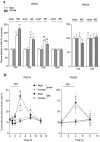Changes in intestinal glucocorticoid sensitivity in early life shape the risk of epithelial barrier defect in maternal-deprived rats
- PMID: 24586321
- PMCID: PMC3930527
- DOI: 10.1371/journal.pone.0088382
Changes in intestinal glucocorticoid sensitivity in early life shape the risk of epithelial barrier defect in maternal-deprived rats
Abstract
Glucocorticoids (GC) contribute to human intestine ontogeny and accelerate gut barrier development in preparation to birth. Rat gut is immature at birth, and high intestinal GC sensitivity during the first two weeks of life resembles that of premature infants. This makes suckling rats a model to investigate postpartum impact of maternal separation (MS)-associated GC release in preterm babies, and whether GC sensitivity may shape MS effects in immature gut. A 4 hours-MS applied once at postnatal day (PND)10 enhanced plasma corticosterone in male and female pups, increased by two times the total in vivo intestinal permeability (IP) to oral FITC-Dextran 4 kDa (FD4) immediately after the end of MS, and induced bacterial translocation (BT) to liver and spleen. Ussing chamber experiments demonstrated a 2-fold increase of permeability to FD4 in the colon immediately after the end of MS, but not in the ileum. Colonic permeability was not only increased for FD4 but also to intact horseradish peroxidase 44 kDa in MS pups. In vivo, the glucocorticoid receptor (GR) antagonist RU486 or ML7 blockade of myosin light chain kinase controlling epithelial cytoskeleton contraction prevented MS-induced IP increase to oral FD4 and BT. In addition, the GR agonist dexamethasone dose-dependently mimicked MS-increase of IP to oral FD4. In contrast, MS effects on IP to oral FD4 and BT were absent at PND20, a model for full-term infant, characterized by a marked drop of IP to FD4 in response to dexamethasone, and decreased GR expression in the colon only compared to PND10 pups. These results show that high intestinal GC responsiveness in a rat model of prematurity defines a vulnerable window for a post-delivery MS, evoking immediate disruption of epithelial integrity in the large intestine, and increasing susceptibility to macromolecule passage and bacteremia.
Conflict of interest statement
Figures





References
-
- Turner JR (2009) Intestinal mucosal barrier function in health and disease. Nat Rev Immunol 9: 799–809. - PubMed
-
- Neu J (2007) Gastrointestinal development and meeting the nutritional needs of premature infants. Am J Clin Nutr 85: 629S–634S. - PubMed
-
- Wagner CL, Taylor SN, Johnson D (2008) Host factors in amniotic fluid and breast milk that contribute to gut maturation. Clin Rev Allergy Immunol 34: 191–204. - PubMed
-
- Maheshwari A, Zemlin M (2006) Ontogeny of the intestinal immune system. Haematol Report 2: 18–26.
Publication types
MeSH terms
Substances
LinkOut - more resources
Full Text Sources
Other Literature Sources
Medical
Miscellaneous

